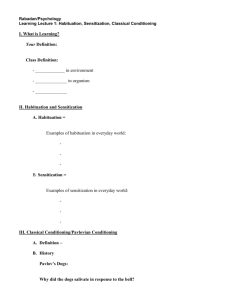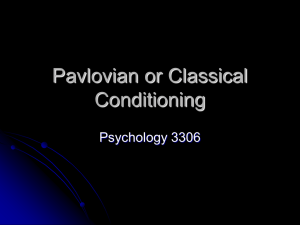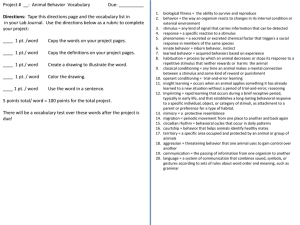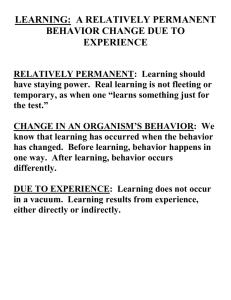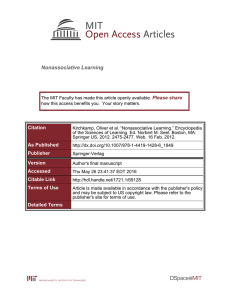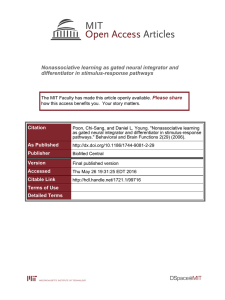PSY402 Theories of Learning
advertisement
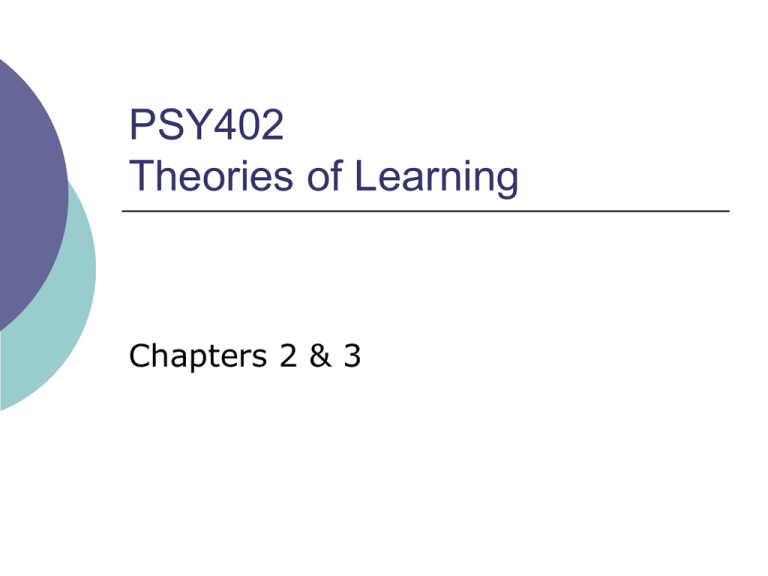
PSY402 Theories of Learning Chapters 2 & 3 Acquisition, Extinction, and Spontaneous Recovery Little Albert Watson & Raynor Human fears can be acquired through Pavlovian conditioning. Rat paired with loud noise Stimulus generalized to other white objects (white rabbit, white fur coat) Mary Cover Jones developed counterconditioning -- a technique for eliminating conditioned fears. Acquisition of fear-inhibiting response Ethics of Learning Research Animals and humans are now protected by oversight and ethical guidelines. Pain or injury to animals must be weighed against and justified by the knowledge to be gained. Electric shock typically is uncomfortable and upsetting but not physically harmful. Instinctive Systems Lorenz & Tinbergen – evolution occurs when a species incorporates environmental knowledge into its genetic structure. Greylag goose and egg-rolling. Learning can sometimes modify instinctive behavior – even though the fixed action patterns are innate. Energy Model Action-specific energy builds up but is blocked (inhibited). The energy motivates appetitive (approach) behavior. Presence of a sign stimulus releases the energy by stimulating an innate releasing mechanism. The behavior occurs as a fixed action pattern (or chain of actions). Releasing Signs Releasing signs can be complex: Grayling butterfly signs include darkness of female, distance from male, and pattern of movement. Intensity of the sign influences the behavior but so does the amount of accumulated energy (time since the last response). Hierarchical System Specific behaviors are controlled by a central instinctive system. Energy can accumulate at each level in the system. Hormones generate energy. Release of energy at higher levels flows to lower levels. The sign stimulus determines which behavior will occur. Conflicting Motives If two incompatible signs appear at the same time, energy flows to a third instinct system. This third behavior is called displacement. Conditioning Affects Behavior Conditioning experiences can change sensitivity to releasing signs. Only the consummatory response (eating, mating) at the end of a chain cannot be changed. Conditioning fine tunes the response to the environment and enhances survival. Criticisms of the Energy Model Best viewed as a metaphor. The brain does not literally accumulate energy in any centers and nothing flows. Willows & Hoyle – alternating contractions in sea slug allow it to escape from a starfish. Brain areas producing this response do not correspond to energy model. Acquired Changes in Response Habituation – response to a repeated stimulus decreases with experience. Sensitization – response to a repeated stimulus increases with experience. Examples: Ingestional neophobia, fear of new food Startle response Experimental Evidence Rats drink little saccharin water at first but increase over time. Loud tones (110 db) produce different responses depending on the background noise (60 vs 80 db). Habituation occurred at 60 db Sensitization occurred at 80 db A loud background is arousing, leading to greater reactivity, not less. Conditions Producing Change More intense (stronger) stimuli produce stronger sensitization, less likely to produce habituation. Greater sensitization and habituation occur when the stimulus is repeated frequently. Changes in the stimulus prevent habituation. Turkeys respond to shape changes. Conditions (Cont.) Sensitization can occur to many kinds of stimuli but habituation occurs only with innate responses. Habituation and sensitization are transient (go away after seconds or minutes between stimuli). Except long-term habituation. Dishabituation – response returns when a sensitizing stimulus occurs. Opponent-Process Theory An explanation for addictions. All experiences produce an affective reaction (pleasant or unpleasant) – called the A state. This reaction gives rise to its opposite – called the B state. B state is less intense and lasts longer. Over time, the A state diminishes and the B state increases. The Addiction Process Tolerance – diminished A state. Withdrawal – increased B state. Addictive behavior is a coping response to the change in B state. People try to enhance A state to offset the unpleasantness of the B state. Without withdrawal symptoms there is no addictive behavior. Time prevents B state strengthening. What Sustains Addiction? The B state is a non-specific aversive feeling. Anything similarly aversive will motivate the addictive behavior, even if it has no relation to the substance. Daily life stress produces a B state that results in behavior to create an A state. Parachute jumpers – create a B state in order to feel the A state. Acquisition of a Conditioned Response Chapter 3, pages 37-46 Acquisition, Extinction, and Spontaneous Recovery Conditioned Emotional Responses Fear is an anticipatory pain response based on past experience. Fear is conditioned whenever a CS is associated with an aversive (painful or negative) event. Fear motivates two responses: Escape (when pain is present) Avoidance (when pain is imminent) Examples of Conditioning Popcorn at the movies. Fear of flying -- stronger with more turbulence (a stronger UCS). An antelope shying away from low tree branches. Nausea at the smell of alcohol after a hangover. Conditioning Situations Sign-tracking (autoshaping) – animals must recognize signs of food (UCS) and respond (UCR). Pigeons pecking at key. UCR, not an operant response, because behavior is specific to the stimulus. Eyeblink conditioning UCR is rapid, CR is slow. Many trials are needed (100 pairings) Fear conditioning Avoidance is not a good measure of fear. Suppression of an operant behavior occurs with a feared stimulus. First – an operant behavior is learned. Second – a CS is paired with an aversive UCS. Third – the CS is presented in the operant chamber. Suppression Ratio During CS SuppressionRatio = During CS + Without CS The amount of time during and without the CS is equal. The more fear, the lower the suppression ratio. Ratios typically fall between 0 and .5 Flavor Aversion Learning Garcia – rats will not drink water with saccharin if they get ill after drinking. Significant avoidance occurs after just one trial. Human food aversions are related to illness (89%). Even if illness occurs hours later it is linked to the previous meal. Not cognitive – know food not to blame

